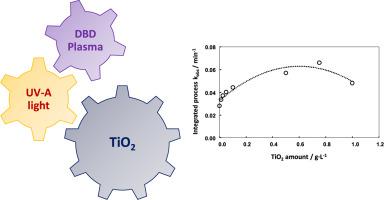Chemosphere ( IF 8.1 ) Pub Date : 2020-09-15 , DOI: 10.1016/j.chemosphere.2020.128336 Annachiara Berardinelli , Abdessalem Hamrouni , Sandra Dirè , Riccardo Ceccato , Giovanni Camera-Roda , Luigi Ragni , Leonardo Palmisano , Francesco Parrino

|
Dielectric barrier discharge plasma and photocatalysis have been proposed as tools for decontamination of process water, especially in food industry. The present investigation aims to redefine and identify the features of coupling the two technologies in terms of degradation efficiency of a model compound. Results show that, when the process is carried out in plasma activated water in the presence of irradiated TiO2, the efficiency of the integrated process is lower than the sum of the two processes acting separately. It is proposed that afterglow species, e.g. hydrogen peroxide and/or peroxynitrites could be activated by UVA light irradiation producing hydroxyl radicals in the liquid phase. Even if TiO2 limits this additional effect by acting as UVA screen barrier material, its decontamination efficiency under certain conditions results higher than that obtained with plasma systems. These results open the route to chlorine-free decontamination processes and redefine the application framework of this integrated approach.
中文翻译:

冷等离子体和光催化耦合工艺对水进行去污的特点和应用
介电势垒放电等离子体和光催化已被提出作为对过程水进行净化的工具,特别是在食品工业中。本研究旨在根据模型化合物的降解效率重新定义和识别结合这两种技术的特征。结果表明,当该工艺在存在TiO 2辐射的情况下在等离子体活化水中进行时,集成工艺的效率低于两个工艺分别作用的总和。提出可以通过UVA光辐照活化余辉物质,例如过氧化氢和/或过氧亚硝酸盐,从而在液相中产生羟基自由基。即使TiO 2通过充当UVA屏幕屏障材料来限制这种附加效果,在某些条件下其去污效率要比等离子系统高。这些结果打开了通向无氯净化过程的途径,并重新定义了这种集成方法的应用框架。











































 京公网安备 11010802027423号
京公网安备 11010802027423号